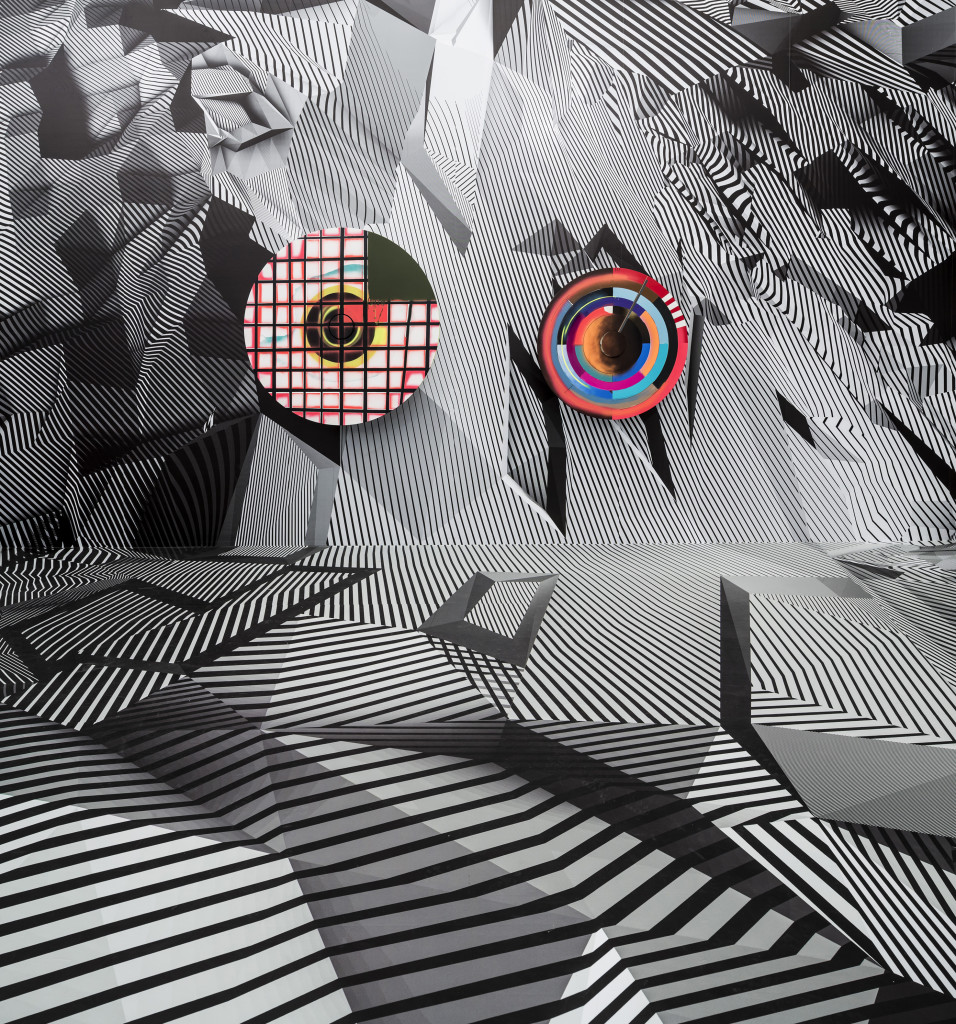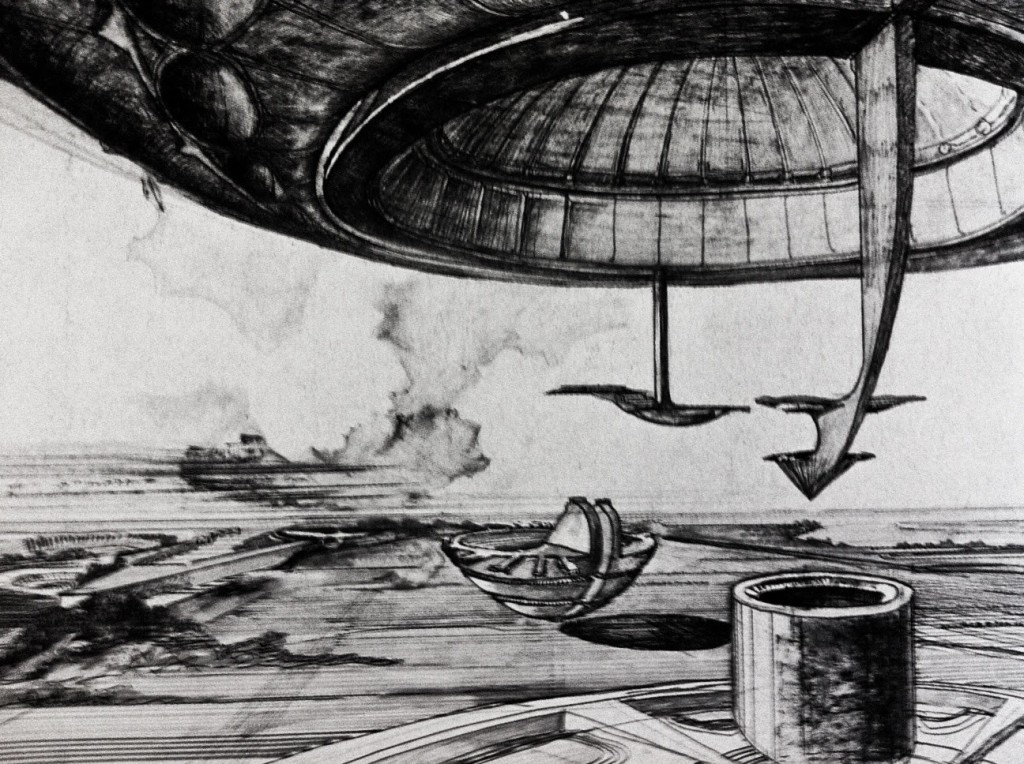Un’astronave mai decollata
text by: Sebastian Di Guardo
L’evoluzione dell’uomo e dello spazio umano sono i concetti cardine su cui sembra vertere l’intera opera del francese naturalizzato romano Luigi Pellegrin, maestro di generazioni di architetti fino alla sua recente scomparsa – e ancora oggi.
La mostra Luigi Pellegrin – copiare da Saturno, dal 24 Gennaio nella galleria Interno 14 di Roma, già nel titolo evoca mondi fantascientifici per proiettarci in una realtà sconvolgente, quella di una mente geniale e idealista. Vi troverete in una dimensione inquietante perché differente dalla nostra attualità. Le sue opere concettuali, come Primordiale “ricordato” prende forma nello spazio, sono ambientate in luoghi mentali, privi della funzione tempo; invece, osservando i più numerosi disegni e plastici architettonici, avrete l’impressione di essere entrati in un’esposizione delle scenografie di Blade Runner, Star Wars o Gundam. Eppure lentamente, aiutati da numerosi indizi, vi accorgerete che non ci troviamo su un altro pianeta ma in una realtà che, pur inedita, rimane tuttavia saldamente legata a processi compositivi per nulla alieni; gli stati della materia e le leggi fisiche e non che regolano la vita sono, infatti, quelli della Terra, e non è un caso.
Secondo Pellegrin ogni stadio dell’evoluzione umana ha coinciso con il gesto dell’alzarsi verso il cielo; questo è accaduto prima per le specie viventi (per esempio le prime piante, l’uomo quadrumane che ha assunto posizione eretta) e in seguito le nostre città (la torre di Babele, i grattacieli di Chicago, ecc). Tale linea evolutiva, sempre secondo Pellegrin, non potrà che aver seguito nella conquista dello spazio, inteso non solo come spazio stellare (era, la sua, l’epoca di Yurij Gagarin) ma –architettonicamente- come luogo potenziale da vivere in libertà. Louis Sullivan e F. L. Wright furono per lui insostituibili maestri in quanto pionieri della demolizione della “scatoletta” muraria. Si tratta di una scelta radicale: gli edifici si librano sul suolo, formano un anello sull’equatore a imitazione di Saturno, divengono MEGA-strutture di scala planetaria, geografica; la tecnologia permette di ottenere qualsiasi cosa si desideri, l’inquinamento non esiste e gli uomini sono liberi e pacifici.
Astronavi. Astronavi che non sono destinate ad andare oltre la stratosfera: sono progetti per le stazioni Tiburtina e Termini di Roma, per scuole, case, quartieri. La villa sulla via Aurelia (sempre a Roma) e il modello costruito in scala 1:1 di un Modulo residenziale in resina polietilene rinforzata ci restituiscono l’immagine di un costruttore, di un uomo legato al cantiere. Pellegrin considerava il suo lavoro come una possibilità e progettava per l’uomo e per la Terra. Aveva la capacità, comune a pochi, di inventare un linguaggio personale e inedito partendo da segni conosciuti. Per questo vi prego: definitelo extra-ordinario, non utopico.
Luigi Pellegrin – Copiare Saturno, mostra a cura di Sergio Bianchi, Galleria Interno 14, Roma
Informazioni/Informations: http://presstletter.com/2014/01/interno-14-mostra-copiare-da-saturno_luigi-pellegrin/
translation by: Laura Dumbrava
A spaceship which never took off
The mankind’s and human space’s evolution is the basic concept on which seems to focus the whole piece of writing of the naturalized roman french author Luigi Pellegrin, utterly known as the master of the generations of architects till his recently death and nowadays too.
Luigi Pellegrin’s display - Copiare da Saturno, on 24th of January at “Interno 14” exhibition in Rome – invoques from its generic title science fiction worlds which aim is to introduce us in an upsetting reality, that of a genial and idealistic mind like the writer’s.
You will be found soon in a disquieting dimension so much different from our actual world.
Pellegrin’s conceptual writings, like Primordiale “ricordato” prende forma nello spazio, are actually rooted in the imaginary self fully detached from time’s passing; however, by observing carefully the numerous drawings and architectural models, you will have the impression that you have suddenly entered the Blade Runner, Star Wars or Gundam scenography exposition.
Nevertheless, by being helped by numerous visual clues, you will slowly notice that we are not on another planet, but in a reality that , although unrevealed, remains anyhow securely linked to the compositional processes, and no to aliens at all. The states of material and physics laws do not change life, it is actually the Earth’s ones which does it.
From Pellgrin’s point of view, every stage of human evolution coincided with the act of lifting up to the sky; this firstly happened for living species such as the first plants, the quadrumana man who proved to had an upright position, and finally our cities such as The Tower of Babel, Chicago’s skyscrapers, etc.
With this evolutionary line, Pellegrin also mentioned the fact that it could not have only tried to conquer the space, seen not only as a interstellar space (see the era of Yurij Gagarin), but as a potential place, from an architectural point of view, in which freedom is preserved. Louis Sullivan and F.LWright were for Pellegrin irreplaceable masters as pioneers in the demolition of “tin” walls. It is in fact a radical choice: the buildings hover out of ground by creating a ring similarly to the Saturn’s one. In this way, they become Megastructures of planetary and geographical scales; technology allows to obtain everything is desirable. The pollution does not exist anymore and men are free and peace-loving.
The spaceships that are not aimed to fly further the stratosphere are the projects for Rome’s Tiburtina and Termini Station, schools, houses, districts. The villa on via Aurelia (also in Rome) and the model built on the scale of 1:1 from the Modulo residenziale in resina polietilene rinforzata restore the image of a builder with a man fond of the construction site.
Pellegrin thought his work to be an opportunity by designing for man and Earth. He had the ability, common to few, to invent a personal and inedited language by starting from unknown signs. For this, I ask you to define him EXTRA-ordinary, and not utopian.
Info:
Info:
Title: Un’astronave mai decollata
Time: 3 febbraio 2014
Category:
Views: 5129 Likes: 5
Tags: -







